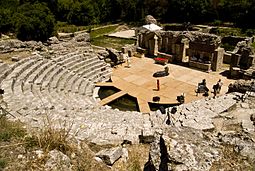Butrint
- Tür: Antik Kent, Ören Yeri
- Tema: UNESCO Dünya Mirası
- Kültür: Antik Yunan, Bizans, Roma
- Yüzyıl: MÖ 10. yy, MÖ 12. yy, MÖ 8. yy
- Bölge: Arnavutluk, Avlonya, Saranda
Butrint (in Albanian) Boυθρωτόν Bouthroton (in Greek) Buthrotum (in Latin) | |
 Theatre of Buthrotum | |
| Location | Vlorë County, Albania |
|---|---|
| Region | Chaonia |
| Coordinates | 39°44′44″N 20°1′14″E / 39.74556°N 20.02056°E |
| Type | Settlement |
| History | |
| Periods | Antiquity and Middle Ages |
| Site notes | |
| Archaeologists | Luigi Maria Ugolini and Hasan Ceka |
| Public access | yes |
| Criteria | Cultural: iii |
| Reference | 570 |
| Inscription | 1992 (16th Session) |
| Extensions | 1999 |
| Endangered | 1997 to 2005 |
| Official name | Butrint |
| Designated | 28 March 2003 |
| Reference no. | 1290[1] |
Butrint (Greek: Βουθρωτόν and Βουθρωτός[2], romanized: Bouthrōtón, Latin: Buthrōtum, Albanian: Butrint) was an ancient Greek polis and later Roman city and the seat of an early Christian bishopric in Epirus.
Originally a settlement of the Greek tribe of the Chaonians,[3][4][5] it later became part of the state of Epirus and later a Roman colonia and a Byzantine bishopric. It entered into decline in Late Antiquity, before being abandoned during the Middle Ages after a major earthquake flooded most of the city. In modern times it is an archeological site in Vlorë County, Albania, some 14 kilometres (8.7 mi) south of Sarandë, close to the Greek border. It is located on a hill overlooking the Vivari Channel and is part of the Butrint National Park. Today Bouthrotum is a Latin Catholic titular see and also features the Ali Pasha Castle.
The city is considered one of the most important archaeological sites in Albania. On the strength of the immense wealth of cultural, historical and natural value with a considerable history, Butrint was declared a UNESCO World Heritage Site in 1992 and further a National Park in 2000 under the leadership of Auron Tare, its first director.[6][7]
- ^ "Butrint". Ramsar Sites Information Service. Retrieved 25 April 2018.
- ^ Stephanus of Byzantium, Ethnica, O709.1
- ^ Borza, Eugene N. (1992). In the Shadow of Olympus: the Emergence of Macedon (Revised ed.). Princeton, New Jersey: Princeton University Press.
Speakers of these various Greek dialects settled different parts of Greece at different times during the Middle Bronze Age, with one group, the 'northwest' Greeks, developing their own dialect and peopling central Epirus. This was the origin of the Molossian or Epirotic tribes. [...] a proper dialect of Greek, like the dialects spoken by Dorians and Molossians. ... The western mountains were peopled by the Molossians (the western Greeks of Epirus).
- ^ Crew, P. Mack (1982). The Cambridge Ancient History – The Expansion of the Greek World, Eighth to Sixth Centuries BC, Part 3: Volume 3 (Second ed.). Cambridge, UK: Cambridge University Press.
That the Molossians... spoke Illyrian or another barbaric tongue was nowhere suggested, although Aeschylus and Pindar wrote of Molossian lands. That they in fact spoke greek was implied by Herodotus' inclusion of Molossi among the Greek colonists of Asia Minor, but became demonstrable only when D. Evangelides published two long inscriptions of the Molossian State, set up p. 369 BC at Dodona, in Greek and with Greek names, Greek patronymies and Greek tribal names such as Celaethi, Omphales, Tripolitae, Triphylae etc. As the Molossian cluster of tribes in the time of Hecataeus included the Orestae, Pelagones, Lyncestae, Tymphaei and Elimeotae, as we have argued above, we may be confident that they too were Greek-speaking.
- ^ Hammond, NGL (1994). Philip of Macedon. London, UK: Duckworth.
Epirus was a land of milk and animal products ... The social unit was a small tribe, consisting of several nomadic or semi-nomadic groups, and these tribes, of which more than seventy names are known, coalesced into large tribal coalitions, three in number: Thesprotians, Molossians and Chaonians ... We know from the discovery of inscriptions that these tribes were speaking the Greek language (in a West-Greek dialect).
- ^ UNESCO. "Butrint". whc.unesco.org.
- ^ "Per Shpalljen Park Kombetar Ne Mbrojtje Te Shtetit Te Zones Arkeologjike Te Butrintit" (PDF). imk.gov.al (in Albanian). Archived from the original (PDF) on 2017-10-27. Retrieved 2018-02-14.
